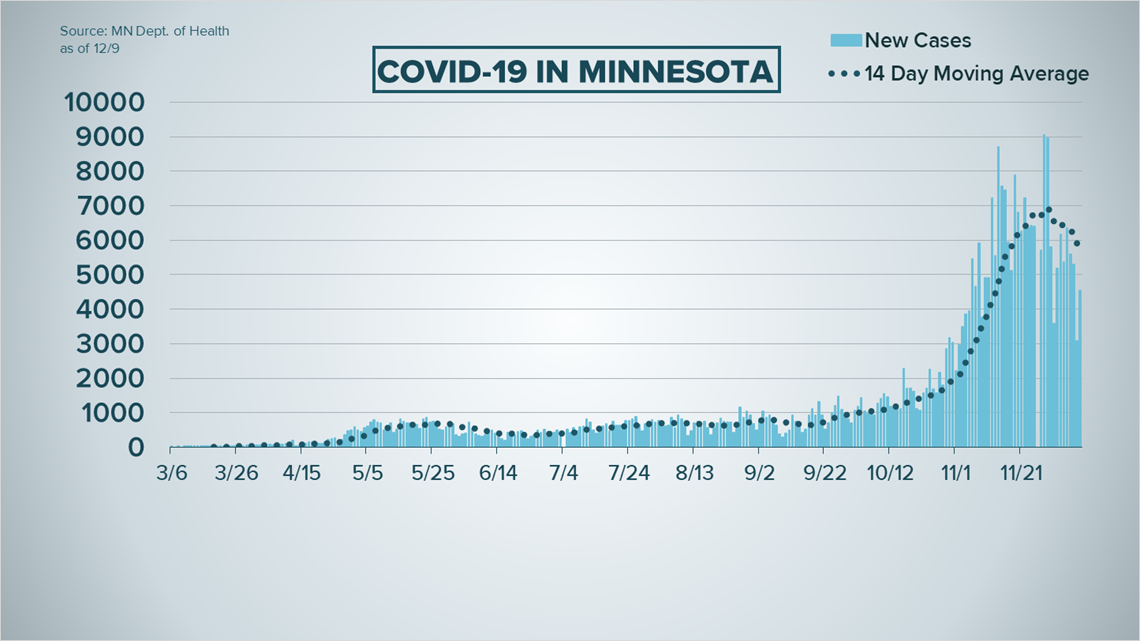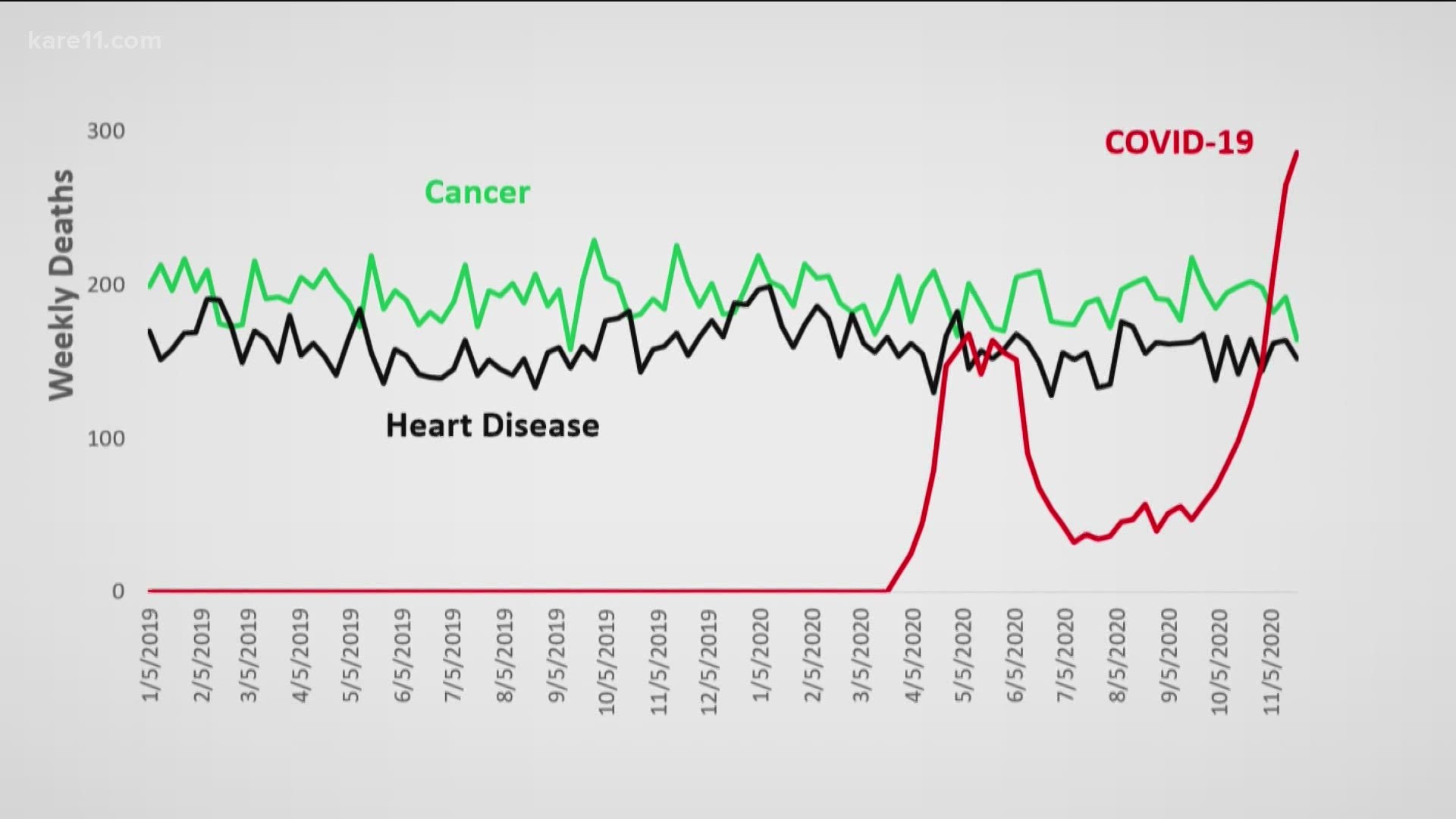ST PAUL, Minn. — Wednesday, Dec. 9
- COVID-19 vaccine to be free of cost
- MDH reports 82 deaths, third-highest single-day total
- Minnesota is expecting to receive 183,000 COVID-19 vaccines over the next month
- People will need to receive two doses of the vaccine
- Minnesota will shorten quarantine period in line with CDC, still asks anyone who's able to quarantine the full 14 days
- Walz may have update on COVID "pause" by week's end
2 p.m.
MDH Commissioner Jan Malcolm said the best thing Minnesotans can do to end the pandemic is to get the vaccine when it is available. Malcolm added that the vaccine is not mandated but getting vaccinated will be encouraged.
The FDA is expected to send guidelines for vaccinations for people with underlying health conditions.
The federal government will cover the cost of the vaccine. It will be free of cost but if you have insurance you will still be asked to show it, Malcolm said.
Clinics may still charge a visit or administration fee, which insurers can cover, Malcolm explained.
11 a.m.
Both reported deaths and new COVID-19 cases jumped in the past day, according to numbers released Wednesday by the Minnesota Department of Health (MDH).
An additional 82 people have died from the virus, bringing total fatalities since the beginning of the pandemic to 4,109. Of those deaths 2,711, or 66% of them are associated with long-term care or assisted living settings.
The 82 deaths are the third-highest single day total reported. Health officials reported 101 deaths Nov. 27, and 92 on Dec. 3.
MDH says 4,539 new cases of coronavirus were registered in the last 24-hour reporting period based on 39,591 tests (34,863 PCR, 4,728 Antigen) processed in private and state labs.
Health officials say a positive PCR test is considered a confirmed case, while a positive Antigen test is listed as a probable case.
In total, 363,719 positive cases have been recorded since the onset of COVID-19. Of those cases 9,129 are based on antigen tests.


Across Minnesota 1,545 hospital beds are currently being used by COVID patients, 358 of them are in ICU. In the Twin Cities 40 ICU beds are listed as available, a rate of 5.8%, while non-ICU beds are tighter with 104 available, a rate of 2.8%.
Total hospitalizations since the beginning of the pandemic are now at 18.809, with 4,106 of those patients requiring care in the ICU.
Young adults make up the majority of Minnesota's coronavirus cases, with those 20 to 24 accounting for 37,982 cases and two deaths. People ages 25 to 29 make up 32,908 cases and four deaths, while 30 to 34-year-olds number 30,383 cases and nine deaths.
The largest grouping of Minnesota's COVID-19 fatalities involves 85 to 89-year-olds, with 771 deaths in 4,676 confirmed cases.
Hennepin County reports the most COVID activity with 76,278 cases and 1,186 deaths, followed by Ramsey County with 32,324 cases and 554 fatalities, Dakota County with 25,988 cases and 220 deaths, and Anoka County with 25,626 cases and 247 deaths.
Cook County in northeastern Minnesota reports the least COVID activity with 93 cases and zero fatalities. It is the only county in the state with cases still in the double-digits. Lake of the Woods County is next lowest with 124 cases and one death.
Tuesday, Dec. 8
2:30 p.m.
Senate Majority Leader Paul Gazelka said the vaccine is not going to be mandated, but that the vaccine does offer the quickest way for life to return back to normal. Gazelka thanked President Trump and Vice President Mike Pence for their work on Operation Warp Speed. Gazelka said he is open to taking the vaccine, but also recently had the virus and says he has antibodies for an unknown period. Gazelka called the vaccine a "lifesaver" for older populations.
MDH Infectious Disease Director Kris Ehresmann said vaccines will begin arriving the week of Dec. 14, and if everything goes according to plan, people can begin getting vaccinated on Dec. 21. People will need two doses that will be given in the interval of around one month.
Ehresmann said people who get vaccinated will receive a card for documentation.
Gov. Tim Walz said the vaccine is a "success story" but infection rates are so high in the country the process of vaccination will take a long time.
1:30 p.m.
Gov. Walz said the state has a solid plan for COVID-19 distribution and the goal is to make it equitable and fair for everyone.
The state aims to partner with federal and local agencies. The federal government is in charge of guaranteeing the safety of the vaccine and local agencies will help get it to Minnesotans, Walz said.
Those who are more susceptible to serious illness and those who care for them will be receiving the vaccine first, Walz said.
Walz urged Minnesotans to not get vaccine information from social media but from reliable sources such as a physician.
Minnesota will be receiving doses from Moderna and Pfizer. The initial supply will be limited but will ramp up as manufacturers can scale production, Walz said.
Walz said 183,000 vaccines are expected to be received over the next four weeks, but the numbers are subject to change.
Both vaccines will require two doses.
MDH Commissioner Jan Malcolm said that while the vaccine distribution is on the horizon, experts are not able to yet say when social distancing and masks will no longer be needed.
MDH Infectious Disease Director Kris Ehresmann said the FDA is expected to give official approval on the Pfizer vaccine on Dec. 10 and the Moderna vaccine on Dec. 17.
It takes around six weeks from getting the vaccine to get protection from COVID-19, Malcolm said.
11 a.m.
New cases of COVID-19 are trending in a positive direction, according to numbers released Tuesday by the Minnesota Department of Health (MDH), but not all markers appear positive.
MDH recorded 3,080 additional cases of the virus in the past 24 hours, more than 2,000 less than the number reported Monday. But testing volume was down as well, making Tuesday's initial positivity rate higher (11.2% vs. 8.1% Monday). Those new cases were based on 27,432 tests (24,743 PCR, 2,689 Antigen) performed in private and state labs in the past day. That volume is less than half of the tests reported Monday.
Health officials regard a positive PCR test as a confirmed case, while a positive Antigen test is considered a probable case.
In all, Minnesota has registered 359,203 cases of coronavirus since the onset of the pandemic. Of those, 8,790 are Antigen-positive cases.
Another 22 Minnesotans have died from the virus, bringing total fatalities to 4,027. Of those deaths 2,660, or 66% are tied to long-term care or assisted living settings.
As of Monday 1,604 hospital beds across the state are currently being used by COVID patients, with 359 of those beds being in the ICU. In the Twin Cities metro, bed availability is down with just 5.4% of ICU beds being open, and 2.9% of non-ICU beds available. The total number of hospitalizations since the start of the pandemic now sits at 18,594, with 4,063 of those patients requiring ICU care.
Young people continue to be the focal point of health officials, as they make up the largest group of cases by a significant margin. Those ages 20 to 24 account for 37,581 cases and two deaths, while people 25 to 29 make up 32,478 cases and four deaths.
The largest grouping of deaths involves those 85 to 89, with 756 fatalities in 4,633 cases.
Hennepin County has the most COVID activity in the state with 75,353 cases and 1,176 deaths, followed by Ramsey County with 31,903 cases and 548 deaths, Dakota County with 25,545 cases ad 218 deaths, and Anoka County with 25,287 cases and 246 deaths.
Cook County in northeastern Minnesota has the least COVID activity with 89 cases and no fatalities, followed by Lake of the Woods County with 123 cases and one death.
KARE 11’s coverage of the coronavirus is rooted in Facts, not Fear. Visit kare11.com/coronavirus for comprehensive coverage, find out what you need to know about the Midwest specifically, learn more about the symptoms, and see what businesses are open as the state slowly lifts restrictions. Have a question? Text it to us at 763-797-7215. And get the latest coronavirus updates sent right to your inbox every morning. Subscribe to the KARE 11 Sunrise newsletter here. Help local families in need: www.kare11.com/give11.
The state of Minnesota has set up a data portal online at mn.gov/covid19.


